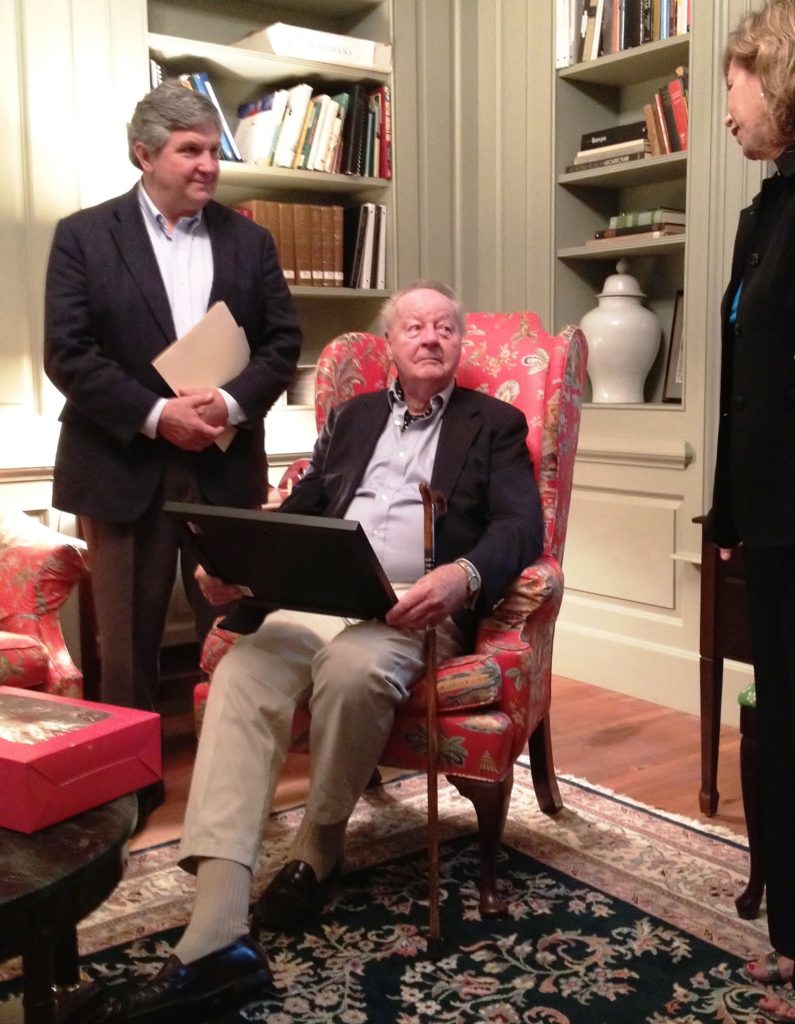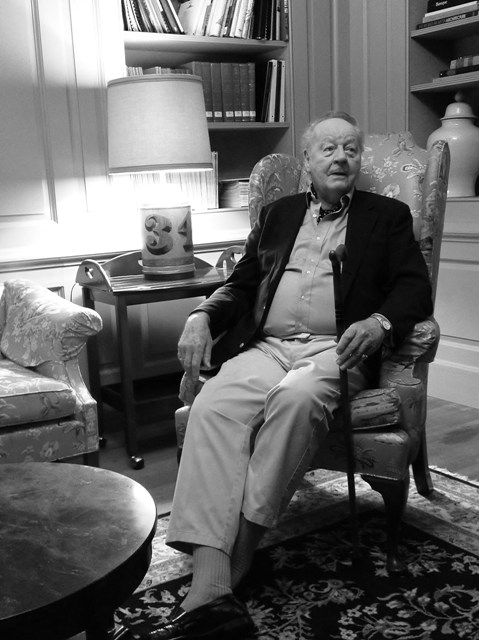Robert E. Lee Barker
With the recent death of Bob Barker, Charleston has lost a wonderful raconteur and one of its most memorable proponents of historic preservation. Though born and reared on Long Island, he grew up with a strong propensity for the South because his mother was a Carter from Virginia and directly related to Robert E. Lee, hence the name she gave him. After reading his grandmother’s diary of coming to Charleston for “race week” (horse racing at now Hampton Park), he visited the city, moved here in the mid-1970s, and made Charleston his home.
Loving history as he did, he restored numerous historic houses, became deeply involved in historic preservation in Charleston, and thanks to preservationist John Meffert, came to Drayton Hall and served as a tour guide soon after its purchase by the National Trust for Historic Preservation, even serving as interim director. In light of the scarcity of visitors in those early days, he and his dear friend Nancy Hudgins used to greet people personally and give tours whenever they arrived.
A graduate of the Parsons School of Design, Bob had an eye for architecture and beauty, as illustrated by the quality with which he restored houses and the advice he gave other preservationists. Upon my arrival as site director in 1989, Bob was the “senior interpreter,” mentoring all new “interpreters,” including me. For special groups, such as those from the Historic Charleston Foundation and Constance Drayton from Philadelphia, Bob was in high demand. He was a remarkable advocate for preservation and was celebrated for selling far more joint memberships to Drayton Hall and the Trust than any individual at any Trust site. Before his retirement a few years ago, Stephanie Meeks, National Trust President, and I recognized Bob with, among other things, a Georgian silver “rice” spoon like the ones he and Drayton Hall guides used on tours as pointers, except this one was not silver plate, but sterling.
Bob loved to hear and tell stories, whether about visitors, staff, or Charleston. One was about two ladies from Georgia who arrived at Drayton Hall in a Cadillac limousine and went on Bob’s tour. They had heard that Drayton Hall’s architectural style was “Georgian Palladian.” Soon after his introduction, Bob heard one of the ladies say to the other, “Why you know I grew up in Georgia, but I’ve never seen anything like this.”
A favorite was a visit by Jackie Onassis. She’d come to Charleston on a yacht and hired a driver to come see Drayton Hall. Greeted at the gatehouse by a young volunteer, who at that time had a clipboard to write down guests’ names, the driver told the volunteer he was bringing Mrs. Jackie Onassis to see the house, to which the gatekeeper replied, “Oh, sure you do.” At which point Jackie lowered her back window, looked at the volunteer, tipped down her dark glasses, and smiled. Stunned, the volunteer dropped his clipboard.
Bob gave her a private tour, and she proved to be knowledgeable about the house, its architecture, and preservation philosophy. The second-floor ceiling of the stair hall was under repair and since there was scaffolding going up the stairs and plaster dust in the air, Bob suggested she probably didn’t want to see the second floor. “I sure do,” she replied. With an appreciative smile, Bob concluded, “She went up in a black dress and came down in a gray one.”
Tour guides at Drayton Hall were fair game, including his friend George Boan. George had a loveable basset, named Beauregard, nicknamed Beau. Much to visitors’ delight, he accompanied George on his tours. According to Bob, Beau “knew how to keep time.” As George spoke in a room, Beau would lay down beside him, but if time was up and George was still talking, Beau would arise and amble into the next room, telling George and visitors alike, “Time to move.”
Another favorite was of a young, attractive tour guide who was an artist and loved to paint dead animals and skeletons. One day she picked up a dead bull frog while returning from a tour with her silver rice spoon still in hand. Visitors asked for directions to the Ashley River, so she complied. As she was talking, Bob said, she wondered why their mouths had dropped as they eyed her one hand and then the other. Only later did she realize she’d been giving directions, stylishly dressed, with a silver spoon in one hand and a dead frog in the other—directions they are, no doubt, still talking about as they recall their visit to Charleston.
Bob loved to tell of his younger years. When he was in the U.S. Army and in New Orleans in 1950, he and a friend were wearing their “dress blue” Army uniforms and visited his great aunt who lived in a beautiful antebellum home. They were greeted at the door by an aged servant, who led them into the parlor and told them he was going to inform Bob’s aunt of their arrival. As they sat there, they heard him say with a soft accent, “Miss Ruth, there’re some Yankee soldiers in the parlor to see you.”
To connect today with his youth, Bob frequently told visitors of his first visit to Drayton Hall in the 1950s, when it was still owned by the Draytons. Upon arrival, he saw a car parked near the house and went up to its tall front doors, knocked, and was invited to come in by Charlotta Drayton, Charles Drayton’s aunt. He demurred, explaining “I have a puppy in the car, and I can’t leave him.” She replied, “Oh, bring him right in.” “Thank you, ma’am, but he’s just a puppy and might have an accident in the house.” She responded, “Bring him right on in. Puppies have been piddling on these floors for 200 years.”
Bob was buried after a lovely but simple service at St. Stephen’s Episcopal Church in Charleston. Many of his friends were there, young and old, including his husband David Johnson. David is an excellent woodworker, and several years ago he had fashioned for Bob a rectangular box for his cremated remains, crafted of special woods and elegant in design. When he gave it to Bob as a present, David recalled, it was one of only two times he had ever seen Bob cry, the other time being when David told Bob he had cancer. My last view of Bob was of this box at the bottom of his shallow burial shaft, with dirt clods that David and the priest had dropped upon it at the conclusion of the Episcopal burial rite.
“Dust to dust. Ashes to ashes. The Lord giveth. The Lord taketh away. Blessed be the name of the Lord.”
I understand the good Lord welcomes “all sorts and conditions of mankind,” and I imagine that Bob, being a Southern gentleman by way of Long Island, will certainly add to the interesting mix. He will also uplift them all with the earthly stories he’s preserved and with style, tell.
– George W. McDaniel
An abbreviated version of the above can be found in my Letter to the Editor of the Post & Courier.
[ A brief video of Bob describing his first visit to Drayton Hall in 1953: ]
To celebrate his life, one may donate to St. Stephen’s Episcopal Church or to the Robert E. Lee Barker Interpretation Fund at Drayton Hall.

With Bob Barker at his Retirement Party in 2012 where staff, friends, Charleston tourism officials, and other well-wishers celebrated his years as senior interpreter at Drayton Hall.
 George W. McDaniel, Ph.D., is President of McDaniel Consulting, LLC, a strategy firm that helps organizations use history to build bridges within itself and to its broader constituents. The company’s tag line, “Building Bridges through History,” is grounded in McDaniel’s personal beliefs and his experience in site management, preservation, education, board development, fundraising, and community outreach. Rather than using history to divide us, he strives to help organizations use history, especially local history, to enhance cross-cultural understanding and to support local museums, preservation, and education. Dr. McDaniel recently led volunteer efforts with Emanuel AME Church and historical organizations in Charleston to use historic preservation to enhance racial reconciliation and healing. McDaniel is also the Executive Director Emeritus of Drayton Hall, a historic site in Charleston, SC, owned by the National Trust for Historic Preservation.
George W. McDaniel, Ph.D., is President of McDaniel Consulting, LLC, a strategy firm that helps organizations use history to build bridges within itself and to its broader constituents. The company’s tag line, “Building Bridges through History,” is grounded in McDaniel’s personal beliefs and his experience in site management, preservation, education, board development, fundraising, and community outreach. Rather than using history to divide us, he strives to help organizations use history, especially local history, to enhance cross-cultural understanding and to support local museums, preservation, and education. Dr. McDaniel recently led volunteer efforts with Emanuel AME Church and historical organizations in Charleston to use historic preservation to enhance racial reconciliation and healing. McDaniel is also the Executive Director Emeritus of Drayton Hall, a historic site in Charleston, SC, owned by the National Trust for Historic Preservation.
A frequent writer, speaker, and facilitator about such issues, he can be reached at gmcdaniel4444@gmail.com or through his website at www.mcdanielconsulting.net.
Header Image: Bob on the occasion of his official retirement from Drayton Hall.

 McDaniel Consulting LLC is a strategy firm that helps organizations use history to build bridges within itself and its broader constituents.
McDaniel Consulting LLC is a strategy firm that helps organizations use history to build bridges within itself and its broader constituents.